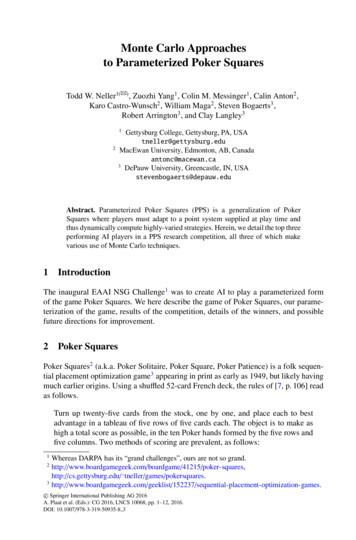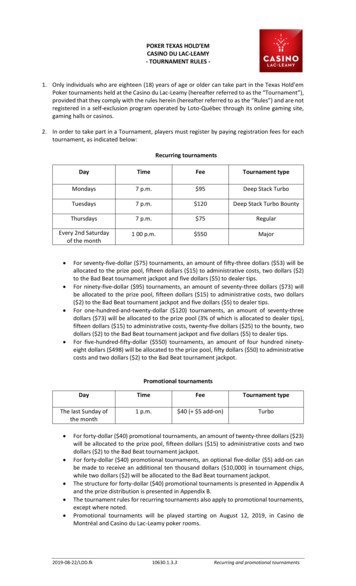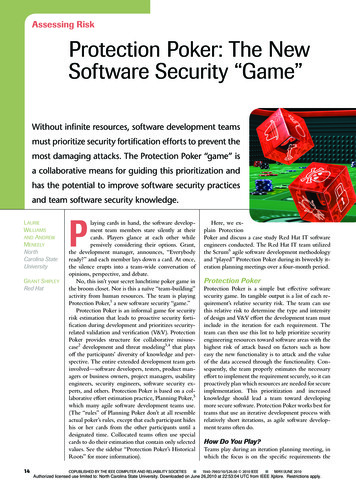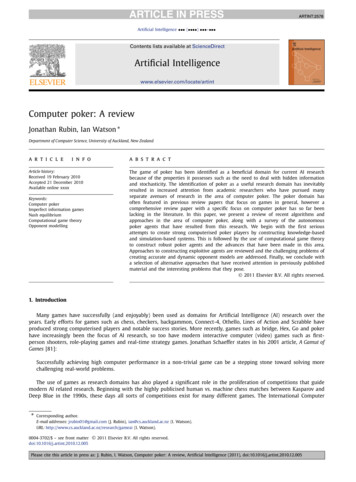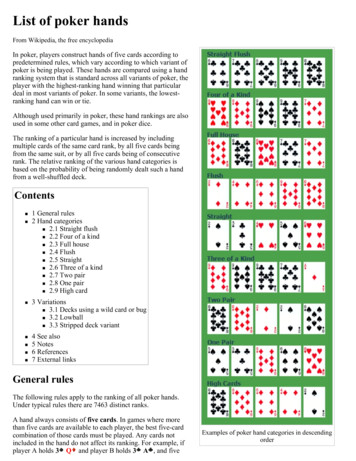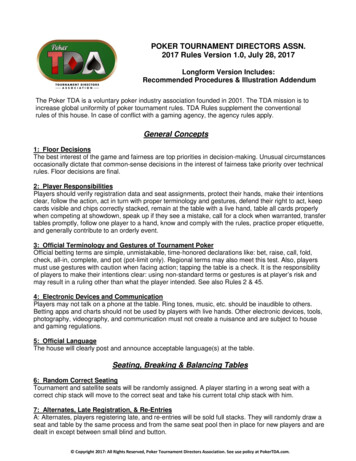
Transcription
POKER TOURNAMENT DIRECTORS ASSN.2017 Rules Version 1.0, July 28, 2017Longform Version Includes:Recommended Procedures & Illustration AddendumThe Poker TDA is a voluntary poker industry association founded in 2001. The TDA mission is toincrease global uniformity of poker tournament rules. TDA Rules supplement the conventionalrules of this house. In case of conflict with a gaming agency, the agency rules apply.General Concepts1: Floor DecisionsThe best interest of the game and fairness are top priorities in decision-making. Unusual circumstancesoccasionally dictate that common-sense decisions in the interest of fairness take priority over technicalrules. Floor decisions are final.2: Player ResponsibilitiesPlayers should verify registration data and seat assignments, protect their hands, make their intentionsclear, follow the action, act in turn with proper terminology and gestures, defend their right to act, keepcards visible and chips correctly stacked, remain at the table with a live hand, table all cards properlywhen competing at showdown, speak up if they see a mistake, call for a clock when warranted, transfertables promptly, follow one player to a hand, know and comply with the rules, practice proper etiquette,and generally contribute to an orderly event.3: Official Terminology and Gestures of Tournament PokerOfficial betting terms are simple, unmistakable, time-honored declarations like: bet, raise, call, fold,check, all-in, complete, and pot (pot-limit only). Regional terms may also meet this test. Also, playersmust use gestures with caution when facing action; tapping the table is a check. It is the responsibilityof players to make their intentions clear: using non-standard terms or gestures is at player’s risk andmay result in a ruling other than what the player intended. See also Rules 2 & 45.4: Electronic Devices and CommunicationPlayers may not talk on a phone at the table. Ring tones, music, etc. should be inaudible to others.Betting apps and charts should not be used by players with live hands. Other electronic devices, tools,photography, videography, and communication must not create a nuisance and are subject to houseand gaming regulations.5: Official LanguageThe house will clearly post and announce acceptable language(s) at the table.Seating, Breaking & Balancing Tables6: Random Correct SeatingTournament and satellite seats will be randomly assigned. A player starting in a wrong seat with acorrect chip stack will move to the correct seat and take his current total chip stack with him.7: Alternates, Late Registration, & Re-EntriesA: Alternates, players registering late, and re-entries will be sold full stacks. They will randomly draw aseat and table by the same process and from the same seat pool then in place for new players and aredealt in except between small blind and button. Copyright 2017: All Rights Reserved, Poker Tournament Directors Association. See use policy at PokerTDA.com.
B: In re-entry events, if a player is permitted to forfeit chips and buy a new stack, the forfeited chips willbe removed from play.8: Special NeedsAccommodations for players with special needs will be made when possible.9: Breaking TablesPlayers from a broken table will be assigned new tables and seats by a 2-step random process. Theycan get any seat including small or big blind or the button and be dealt in except between the smallblind and button. See Illustration Addendum.10: Balancing Tables and Halting PlayA: To balance in flop & mixed-games, the player who will be big blind next is moved to the worstposition, including taking a single big blind when available, even if that means the seat has the big blindtwice. Worst position is never the small blind. In stud-only, players move by position (last seat to openat the short table is the seat filled).B: In mixed games (ex: HORSE), when the game shifts from hold’em to stud, after the last hold’emhand the button moves to the position it would be if the next hand was hold’em and is frozen thereduring stud. The player moved in stud is the player who would be big blind if the game were hold’em forthat hand. Shifting to hold'em the button starts where it was frozen.C: The table from which a player is moved will be specified by a predetermined procedure.D: Full-table play will halt on tables 3 or more players short of the table with the most players. Play haltson other formats (ex: 6-hand and turbos) at TDs discretion. TDs may waive halting play and waiver isnot a misdeal. As the event progresses, at TD’s discretion tables may be more tightly balanced.11: Number of Players at Final TableFinal tables will have a full table for the event, plus one. (9-handed events seat 10 at the final table, 8handed stud seats 9, 6-handed seats 7, etc.). No final table should seat more than 10. This rule doesnot apply to heads-up events.Pots / Showdown12: Declarations. Cards Speak at ShowdownCards speak to determine the winner. Verbal declarations of hand value are not binding at showdownbut deliberately miscalling a hand may be penalized. Any player in the hand or not, should speak up ifhe or she thinks a mistake is being made in reading hands or awarding the pot.13: Tabling Cards & Killing Winning HandA: Proper tabling is both 1) turning all cards face up on the table and 2) allowing the dealer and playersto read the hand clearly. “All cards” means both hole cards in hold’em, all 4 hole cards in Omaha, all 7cards in 7-stud, etc. Dealers should read and announce hand values at showdown.B: At showdown a player must protect his hand while waiting for it to be read (See also Rule 66). If aplayer does not fully table his cards, then mucks thinking he has won, he does so at his risk. If thecards are not 100% retrievable and identifiable and the TD rules the hand was not clearly read, theplayer has no claim to the pot. The TDs decision on whether a hand was sufficiently tabled is final.C: Dealers cannot kill a properly tabled hand that was obviously the winner. Copyright 2017: All Rights Reserved, Poker Tournament Directors Association. See use policy at PokerTDA.com.
14: Live Cards at ShowdownDiscarding non-tabled cards face down does not automatically kill them; a player may change her mindand table her cards if they remain 100% identifiable and retrievable. Cards are killed by the dealerwhen pushed into the muck or otherwise rendered irretrievable and unidentifiable.15: Showdown and Discarding IrregularitiesA: If a player tables one card that would make a winning hand, the dealer should advise the player totable all cards. If he refuses, the floor should be called.B: If a player bets then discards thinking she has won (forgetting that another player is still in the hand),the dealer should hold the cards and call the floor. If the cards are mucked and not retrievable andidentifiable to 100% certainty, the player has no redress and is not entitled to a refund of called bets. Ifthe player initiated a bet or raise and hasn’t been called, the uncalled amount will be returned to her.16: Face Up for All-InsAll hands will be tabled without delay once a player is all-in and all betting action by all other players inthe hand is complete. No player who is either all-in or has called all betting action may muck his or herhand without tabling. All hands in both the main and side pot(s) must be tabled and are live. SeeIllustration Addendum.17: Non All-In Showdowns & Showdown OrderA: In a non all-in showdown, if cards are not spontaneously tabled or discarded, the TD may enforce anorder of show. The last aggressive player on the final betting round (final street) must table first. If therewas no final round bet, the player who would act first in a final betting round must table first (i.e. firstseat left of the button in flop games, high hand showing in stud, low hand in razz, etc.).B: A non all-in showdown is uncontested if all but one player mucks face down without tabling. The lastplayer with live cards wins and he is not required to show his cards.18: Asking to See a HandA: Players not still in possession of cards at showdown, or who have mucked their cards face downwithout tabling, lose any rights or privileges to ask to see any hand.B: If there was a river bet, any caller has an inalienable right to see the last aggressor’s hand onrequest (“the hand he paid to see”) provided the caller retains or has tabled his cards. TDs discretiongoverns all other requests such as to see the hand of another caller, or if there was no river bet. SeeIllustration Addendum [adopted 2013].19: Playing the Board at ShowdownTo play the board, a player must table all hole cards to get part of the pot (See Rule 13-A).20: Awarding Odd ChipsFirst, odd chips will be broken into the smallest denomination in play. A) Board games with 2 or morehigh or low hands: the odd chip goes to the first seat left of the button. B) Stud, razz, and if 2 or morehigh or low hands in stud/8: the odd chip goes to the high card by suit in the player’s 5-card winninghand. C) H/L split: the odd chip in the total pot goes to the high side. D) If identical hands win both highand low (ex: 2 Omaha/8 wheels) the pot is split as evenly as possible. See Illustration Addendum.21: Side PotsEach side pot will be split separately.22: Disputed Hands and PotsThe reading of a tabled hand may be disputed until the next hand begins (see Rule 23). Accountingerrors on awarding of the pot may be disputed until substantial action occurs on the next hand. If ahand finishes during a break, the right to any dispute ends 1 minute after the pot is awarded. Copyright 2017: All Rights Reserved, Poker Tournament Directors Association. See use policy at PokerTDA.com.
General Procedures23: New Hand & New LimitsA new level will not be announced until the clock reaches zero. The new level applies to the next hand.A hand begins on the first riffle, push of the shuffler button, or on the dealer push.24: Chip Race, Scheduled Color UpsA: At scheduled color-ups, chips will be raced off starting in seat 1, with a maximum of one chipawarded to a player. Players can’t be raced out of play: a player losing her last chip(s) in a race will get1 chip of the lowest denomination still in play.B: Players must have their chips fully visible and are encouraged to witness the chip race.C: If after the race, a player still has chips of a removed denomination, they will be exchanged forcurrent denominations only at equal value. Chips of removed denominations that do not fully total atleast the smallest denomination still in play will be removed without compensation.25: Cards & Chips Kept Visible, Countable, & Manageable. Discretionary Color-UpsA: Players are entitled to a reasonable estimation of their opponents’ chip counts; thus chips should bekept in countable stacks. The TDA recommends clean stacks of 20 chips each as a standard. Higherdenomination chips must be visible and identifiable at all times.B: TDs control the number and denominations of chips in play and may color up at their discretion.Discretionary color ups are to be announced.C: Players must keep live hands in plain view at all times.26: Deck ChangesDeck changes will be on the dealer push or level changes or as prescribed by the house. Players maynot ask for deck changes.27: Re-buysPlayers may not miss a hand. If a player declares intent to rebuy before a hand, she is playing chipsbehind and must make the re-buy.28: Rabbit HuntingRabbit hunting (revealing cards that would have come if the hand had not ended) is not allowed.29: Calling for a ClockIf in TD’s judgement reasonable time has passed, he or she may call the clock or approve a clockrequest by any player in the event. A player on the clock has up to 25 seconds plus a 5 secondcountdown to act. If the player faces a bet and time expires, the hand is dead; if not facing a bet, thehand is checked. A tie goes to the player. TDs may adjust the time allowed and take other steps to fitthe game and stop persistent delays. See also Rules 2 and 71.Player Present / Eligible for Hand30: At Your Seat and Live HandsTo have a live hand, a player must be at his seat when the last card is dealt to all players on the initialdeal. A player not then at his seat may not look at his cards, and the hand is immediately killed. Hisblinds and antes are posted and if dealt the stud bring-in card he posts the bring-in. A player must be athis seat to call for a clock (Rule 29). “At your seat” means in reach of your chair. This rule is notintended to encourage players to be out of their seats while in a hand. Copyright 2017: All Rights Reserved, Poker Tournament Directors Association. See use policy at PokerTDA.com.
31: At the Table with Action PendingPlayers with live hands (including players all-in or otherwise finished betting) must remain at the tablefor all betting rounds and showdown. Leaving the table is incompatible with protecting your hand andfollowing the action, and is subject to penalty.Button / Blinds32: Dead ButtonTournament play will use a dead button.33: Dodging BlindsPlayers who intentionally dodge any blind when moving from a broken table will incur a penalty.34: Button in Heads-upWhen heads-up, the small blind has the button, is dealt the last card, and acts first pre-flop and last onall other streets. When starting heads-up play, the button may need to be adjusted to ensure no playerhas the BB twice in a row.Dealing Rules35: MisdealsA: Misdeals include but are not necessarily limited to: 1) 2 or more boxed cards on the initial deal; 2)first card dealt to the wrong seat; 3) cards dealt to a seat not entitled to a hand; 4) a seat entitled to ahand is dealt out; 5) In stud, if any player’s first 2 downcards are exposed by dealer error; 6) In flopgames, if 1 of the first 2 cards dealt off the deck or any other 2 downcards are exposed by dealer error.House standards apply for draw games (ex: lowball).B: Players may be dealt 2 consecutive cards on the button.C: In a misdeal, the re-deal is an exact re-play: the button does not move, no new players are seated,and limits stay the same. Cards are dealt to players on penalty or not at their seats for the original deal(see Rule 30), then their hands are killed. The original deal and re-deal count as one hand for a playeron penalty, not two.D: Once substantial action occurs a misdeal cannot be declared; the hand must proceed (See Rule 36).36: Substantial ActionSubstantial Action is either A) any 2 actions in turn, at least one of which puts chips in the pot (i.e. any 2actions except 2 checks or 2 folds) or B) any combination of 3 actions in turn (check, bet, raise, call,fold). See Rules 35-D & 43-B.Rule 37: Button with Too Few CardsIf the button is dealt too few cards, he should announce it immediately. Missing button cards may bereplaced even after substantial action if permitted for the game type. However, if he acts on a hand withtoo few cards, the hand is dead.Rule 38: Burns After Substantial ActionThe purpose of the burn card is to protect the stub, not to “preserve the card order”. If substantial actionoccurs and a hand is killed due to the wrong number of cards, randomness applies to further dealing.The stub is treated as a normal stub and one and only one card is burned off the stub for each street.See Illustration Addendum. Copyright 2017: All Rights Reserved, Poker Tournament Directors Association. See use policy at PokerTDA.com.
39: Four-Card Flops and Premature CardsIf the flop has 4 rather than 3 cards, exposed or not, the floor will be called. The dealer then scramblesthe 4 cards face down, the floor randomly selects one as the next burn card and the other 3 are theflop. For prematurely dealt cards, see Recommended Procedure 5.Play: Bets & Raises40: Methods of Betting: Verbal and ChipsA: Bets are by verbal declaration and/or pushing out chips. If a player does both, whichever is firstdefines the bet. If simultaneous, a clear and reasonable verbal declaration takes precedence, otherwisethe chips play. In unclear situations or where verbal and chips are contradictory, the TD will determinethe bet based on the circumstances and Rule 1. See Illustration Addendum.B: Verbal declarations may be general (“call”, “raise”), a specific amount only (“one thousand”) or both(“raise, one thousand”).C: For all betting rules, declaring a specific amount only is the same as silently pushing out an equalamount. Ex: Declaring “two hundred” is the same as silently pushing out 200 in chips.41: Acting in TurnA: Players must act in turn verbally and/or by pushing out chips. Action in turn is binding and commitschips to the pot that stay in the pot.B: Players must wait for clear bet amounts before acting. Ex: NLHE, A says “raise” (but no amount),and B quickly folds. B should wait to act until A’s raise amount is clear.42: Binding Declarations / Undercalls in TurnA: General verbal declarations in turn (such as “call” or “raise”) commit a player to the full currentaction. See Illustration AddendumB: A player undercalls by declaring or pushing out less than the call amount silently (without firstdeclaring “call”). An undercall is a mandatory full call if made in turn facing 1) any bet heads-up or 2)the opening bet on any round multi-way. In other situations, TD’s discretion applies. The opening bet isthe first chip bet of each round (not a check); the posted BB is the opening pre-flop bet in blind games.All-in buttons greatly reduce undercall frequency (See Recommended Procedure 1). This rule governswhen a player must make a full call and when, at TDs discretion she may forfeit the underbet and fold.C: If two or more undercalls occur in sequence, play backs up to the first undercaller who must correcther bet per Rule 42-B. The TD will determine how to treat hands of the remaining players based on thecircumstances.43: Action Out of Turn (OOT)A: Any action out of turn (check, call, or raise) will be backed up to the correct player in order. The OOTaction is subject to penalty and is binding if action to the OOT player does not change. A check, call orfold by the correct player does not change action. If action changes, the OOT action is not binding; anybet or raise is returned to the OOT player who has all options: call, raise, or fold. An OOT fold isbinding. See Illustration Addendum.B: A player skipped by OOT action must defend his right to act. If the skipped player had reasonabletime and does not speak up before substantial action (Rule 36) OOT occurs to his left, the OOT actionis binding. Action backs up and the floor will rule on how to treat the skipped hand, including ruling adead hand or limiting to non-aggressive action as the TD sees fit under the circumstances. SeeIllustration Addendum. Copyright 2017: All Rights Reserved, Poker Tournament Directors Association. See use policy at PokerTDA.com.
44: Methods of CallingStandard and acceptable forms of calling include: A) saying “call”; B) pushing out chips equal to a call;C) silently pushing out an overchip; or D) silently pushing out multiple chips equal to a call under themulti-chip rule (Rule 49). Silently betting chip(s) relatively tiny to the bet (ex: blinds 2k-4k. A bets 50k, Bthen silently puts out one 1k chip) is non-standard, strongly discouraged, subject to penalty, and will beinterpreted at TDs discretion, including being ruled a full call.45: Methods of RaisingIn no-limit or pot-limit, a raise must be made by A) pushing out the full amount in one motion; B)verbally declaring the full amount prior to pushing out chips; or C) verbally declaring “raise” prior topushing out the exact call amount then completing the raise in one additional motion. In option C, ifother than the exact call amount but less than a minimum raise is first put out, it will be ruled a minimumraise. It is the responsibility of players to make their intentions clear.46: Raise AmountsA: A raise must be at least equal to the largest prior bet or raise of the current betting round. If a playerraises 50% or more of the largest prior bet but less than a minimum raise, he must make a full minimumraise. If less than 50% it is a call unless “raise” is first declared. Declaring an amount or pushing out thesame amount of chips is treated the same (See Rule 40-C). Ex: NLHE, opening bet is 1000, verballydeclaring “Fourteen hundred” or silently pushing out 1400 in chips are both calls unless raise is firstdeclared. See Illustration Addendum.B: Without other clarifying information, declaring raise and an amount is the total bet. Ex: A opens for2000, B declares “Raise, eight thousand.” The total bet is 8000.47: Re-Opening the Bet.In no-limit and pot limit, an all-in wager (or multiple short all-ins) totaling less than a full bet or raisedoes not reopen betting for a player who has already acted and is not facing at least a full bet or raisewhen the action returns to her. In limit, at least 50% of a full bet or raise is required to re-open bettingfor players who have already acted. See Illustration Addendum.48: Oversized Chip BettingIf facing a bet or blind, pushing out a single oversized chip (including your last chip) is a call if raise isn’tfirst declared. To raise with an overchip you must declare raise before the chip hits the table surface. Ifraise is declared but no amount is stated, the raise is the maximum allowable for the chip. If not facinga bet, pushing out an oversized chip silently (no declaration) is a bet of the maximum for the chip.49: Multiple Chip BettingWhen facing a bet, unless raise is declared first, a multiple-chip bet (including a bet of your last chips) isa call if every chip is needed to make the call; i.e. removal of just one of the smallest chips leaves lessthan the call amount. Example: preflop, 200-400 blinds: A raises to 1200 total (an 800 raise), B puts outtwo 1000 chips without declaring raise. This is just a call because removing one 1000 chip leaves lessthan the amount to call (1200). If the single removal of just one of the smallest chips leaves the callamount or more, the bet is governed by the 50% standard in Rule 46. See Addendum.50: Prior Bet Chips Not Pulled InA: If a player bets when facing a raise and has chips in front of her not yet pulled in from a prior bet,several factors affect whether her action is ruled a call or re-raise. These factors include: whether theprior chips cover the bet, whether any of the prior chips are pulled back, whether all the new chips areneeded to call, and any gestures the player makes. Because several possibilities exist, players areadvised to verbally declare their bets before putting out new chips on top of prior-bet chips not yetpulled in. See Illustration Addendum for specific examples.B: If facing action, clearly pulling back a prior bet chip binds a player to call or raise; she may not putthe chip(s) back out and fold. Copyright 2017: All Rights Reserved, Poker Tournament Directors Association. See use policy at PokerTDA.com.
51: Number of Allowable RaisesThere is no cap on the number of raises in no-limit and pot-limit. In limit play, there is a limit to raiseseven when heads-up until the event is down to 2 players; the house limit applies.52: Accepted ActionPoker is a game of alert, continuous observation. It is the caller’s responsibility to determine the correctamount of an opponent’s bet before calling, regardless of what is stated by others. If a caller requests acount but receives incorrect information from a dealer or player, then pushes out that amount, the callerhas accepted the full correct action & is subject to the correct wager or all-in amount. As with allsituations, Rule 1 may apply at TD’s discretion.53: Pot Size & Pot-Limit BetsA: Players are entitled to a pot count in pot-limit only. Dealers will not count the pot in limit and no-limit.B: Pre-flop a short all-in blind will not affect calculation of the maximum pot limit bet. Post-flop, bets arebased on actual pot size.C: Declaring “I bet the pot” is not a valid bet in no-limit but it does bind the player to making a valid bet(at least a minimum bet), and may be subject to penalty. If the player is facing a bet he must make avalid raise.Rule 54: Incorrect Bet AmountsA: In pot limit, if a player bets the pot based on an inaccurate count, if the pot count is too high (anillegal bet), it will be corrected for all players anywhere on the current street; if too low, corrected untilsubstantial action occurs after the bet. See Illustration Addendum.B: In non-PL games, incorrect bets are adjusted to the proper amount anywhere on the current street.Ex: NLHE, A opens for 10k, B raises to 18k (a 2k under-raise), this error will be corrected anywhere onthis betting round.Rule 55: Invalid Bet DeclarationsIf a player faces no bet and: A) declares “call”, it is a check; B) declares “raise”, the player must makeat least a min-bet. A player declaring “check” when facing a bet may call or fold, but cannot raise.56: String Bets and RaisesDealers will call string bets and raises.57: Non-Standard & Unclear BettingPlayers use unofficial betting terms and gestures at their own risk. These may be interpreted to meanother than what the player intended. Also, if a declared bet can reasonably have multiple meanings, itwill be ruled based on the highest reasonable amount that is less than the pot size before the bet. Ex:NLHE 200-400 blinds, 4900 in the pot, player declares “I bet five.” With no other clarifying information,the bet is 500; if 5100 in the pot, the bet is 5000. See Rules 2, 3 & 45.58: Non-Standard FoldsAny time before the end of the final betting round, folding in turn if there’s no bet to you (ex: facing acheck or first to act post-flop) or folding out of turn are binding folds subject to penalty.59: Conditional StatementsConditional statements of future action are non-standard and strongly discouraged. At TDs discretionthey may be binding and/or penalized. Example: “if – then” statements such as "If you bet, I will raise.” Copyright 2017: All Rights Reserved, Poker Tournament Directors Association. See use policy at PokerTDA.com.
Rule 60: Bet Amount Not EstablishedIf Player A declares “bet” or “raise” and B declares call before A’s exact bet amount is established, theTD will rule the bet as best fits the situation including possibly obliging B to call any amount.61: Count of Opponent’s Chip StackPlayers are entitled to a reasonable estimation of opponents’ chip stacks (Rule 25). A player may onlyrequest a more precise count if the action is on him and he faces an all-in bet. The all-in player is notrequired to count; on request the dealer or floor will count it. Accepted action applies (See Rule 52).The visible and countable chip stack rule (Rule 25) greatly helps accuracy in counting.62: Over-Betting Expecting ChangeBetting should not be used to obtain change. Pushing out more than the intended bet can confuseeveryone at the table. All chips pushed out silently are at risk of being counted in the bet. Example: Theopening bet is 325 to player A and she silently puts out 525 (one 500 and one 25), expecting 200change. This is a raise to 650 under the multiple chip rule (Rule 49).63: All-In with Chips Found Behind LaterIf A bets all-in and a hidden chip is found behind after a player has called, the TD will determine if thechip behind is part of accepted action (Rule 52). If not part of the action, A will not be paid off for thechip(s) if she wins. If A loses she is not saved by the chip(s) and the TD may award the chip(s) to thewinning caller.Play: Other64: Chips Out of View and in TransitPlayers may not hold or transport chips in a way that takes them out of view. A player who does so willforfeit the chips and may be disqualified. The forfeited chips will be taken out of play. The TDArecommends the house provide racks or bags to transport chips when needed.65: Lost and Found ChipsLost and found chips will be taken out of play and returned to tournament inventory.66: Accidentally Killed / Fouled / Exposed HandsA: A player must protect his hand at all times, including at showdown while waiting for the hand to beread. If the dealer kills a hand by mistake or if in TDs judgement a hand is fouled and cannot beidentified to 100% certainty, the player has no redress and is not entitled to a refund of called bets. Ifthe player initiated a bet or raise and hasn’t been called, the uncalled amount will be returned to him.B: If a hand is fouled but can be identified, it remains in play despite any cards exposed.67: Dead Hands and Mucking in StudIn stud poker, if a player picks up the upcards while facing action, the hand is dead. Proper mucking instud is turning down all up cards and pushing them all forward face down.Etiquette & Penalties68: No DisclosurePlayers must protect other players in the tournament at all times. Therefore players, whether in thehand or not, must not:1. Discuss contents of non-tabled live or mucked hands,2. Advise or criticize play at any time,3. Read a hand that hasn't been tabled.One-player-to-a-hand is in effect. Among other things, this rule prohibits showing a hand to ordiscussing strategy with another player, advisor, or spectator. Copyright 2017: All Rights Reserved, Poker Tournament Directors Association. See use policy at PokerTDA.com.
69: Exposing Cards and Proper FoldingA player who exposes her cards with action pending may incur a penalty, but will not have a deadhand. The penalty will begin at the end of the hand. When folding, cards should be pushed forward lowto the table, not deliberately exposed or tossed high (“helicoptered”). See also Rule 67.70: Ethical PlayPoker is an individual game. Soft play will result in penalties, which may include chip forfeiture and/ordisqualification. Chip dumping and other forms of collusion will result in disqualification.71: Etiquette ViolationsEtiquette violations are subject to enforcement actions in Rule 72. Examples include but are not limitedto: persistent delay of the game, unnecessarily to
The Poker TDA is a voluntary poker industry association founded in 2001. The TDA mission is to increase global uniformity of poker tournament rules. TDA Rules supplement the conventional rules of this house. In case of conflict with a gaming agency, the agency rules apply. General Concepts 1: Floor Decisions
